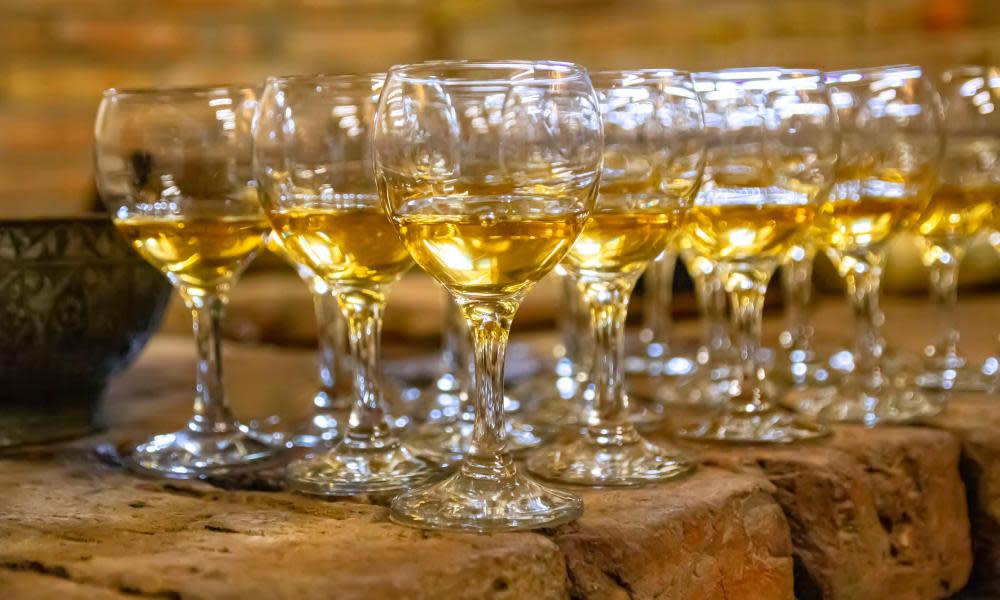Is orange wine the future?

It’s easy to be snippy about orange wine, especially given a recent trends report by Sainsbury’s which suggests that almost a third of 25- to 34-year-olds would buy the stuff simply because it would look good on their Instagram feeds. Coupled with the fact that some orange wines taste unconscionably like cider, and at three or four times the price, you might well wonder what all the fuss is about.
Well, for a start, orange wine is no flash in the pan – in Georgia, they’ve been making it for all of 2,000 years, in terracotta amphorae called qvevri. And no, it’s not made from oranges, either, but from white grapes: the freshly crushed juice is left in contact with the skins to pick up colour, in much the same way as reds and rosés are, and the longer the contact, the deeper the colour will be – some orange wines have a particularly beautiful, amber hue.
Sainsbury’s is not the first supermarket to show an interest in them, either. Marks & Spencer has been selling an amphora-fermented Georgian wine for some time now, while last year Asda launched a Romanian orange wine. Sainsbury’s has recently taken on one from the South African producer Bosman, who already have a track record with the style: they’ve given this one 21 days’ skin contact, which makes it a pale-ish orange and which, combined with a relatively low level of alcohol, has an appealingly soft, peachy flavour that should develop over the coming months. Of course, a single wine isn’t exactly a ringing endorsement of the trend Sainsbury’s has identified, but baby steps and all that.
A couple of other things you need to know about orange, or amber wines, as they’re also known, are that you should serve them warmer than a standard white – about 12-14C – and that they take well to being decanted. They also have the structure and tannin to stand up to red meat, especially lamb, in a way that white wines tend not to. And they’re particularly good with Middle Eastern food.
If you’re daunted by the price and unsure whether orange wine is going to be your thing, your best option is to try them by the glass in one of the many natural wine bars that have sprung up in in the past few years. “We recently had three orange wines in our top 10 sellers,” says Doug Wregg of natural wine specialist Les Caves de Pyrène. “Normally, there are none in our top 30. People wanted a psychological lift during lockdown, and there’s something about orange wine that gives one that.” To coin a phrase, perhaps the future is orange, after all.
Go with the glow: six orange wines to try
Bosman Nature & Sun Skin-Contact Chenin Blanc 2020 £10 Sainsbury’s, 11.5%. Light and delicate South African – a perfect introduction to orange wine. Not as rich and textured as the same producer’s excellent Fides Grenache Blanc, but quite a bit cheaper.
Matrobela Wines Rkatsiteli Amber Dry 2018 £17 tasteofgeorgia.co.uk, 13%. Classic, rich, quince-flavoured wine from the home of orange wine.
Lovamor Vino de la Tierra de Castilla y Leon 2019 £17.10 Les Caves de Pyrène, £17.95 Brooksteed Bottle and Jug, 13.5%. Orange wine has quite a following in Spain and this unfiltered 100% albillo does actually taste quite orangey, so I’d say it’s one for existing natural wine fans, rather than newbies.
Skinny Dip 2018 £28 Forest Wines, Gnarly Vines, 11.5%. Beguilingly fragrant, almost floral wine from Wiltshire, of all places. Made from organic solaris grapes and unfiltered. Glorious.
Naranjo Torontel 2019 £15.25 Corney & Barrow, Hic Yorkshire, 13.5%. Dramatically deep-coloured, rich Chilean that could even handle a steak.
La Macération du Soula Orange No 19, Vin du Fenouillèdes £26.95 Uncorked, 13%. Sumptuously rich wine from the Roussillon that tastes even better three days after opening (if it lasts that long). Basically, a fine wine that just happens to be orange.
•For more by Fiona Beckett, go to matchingfoodandwine.com


